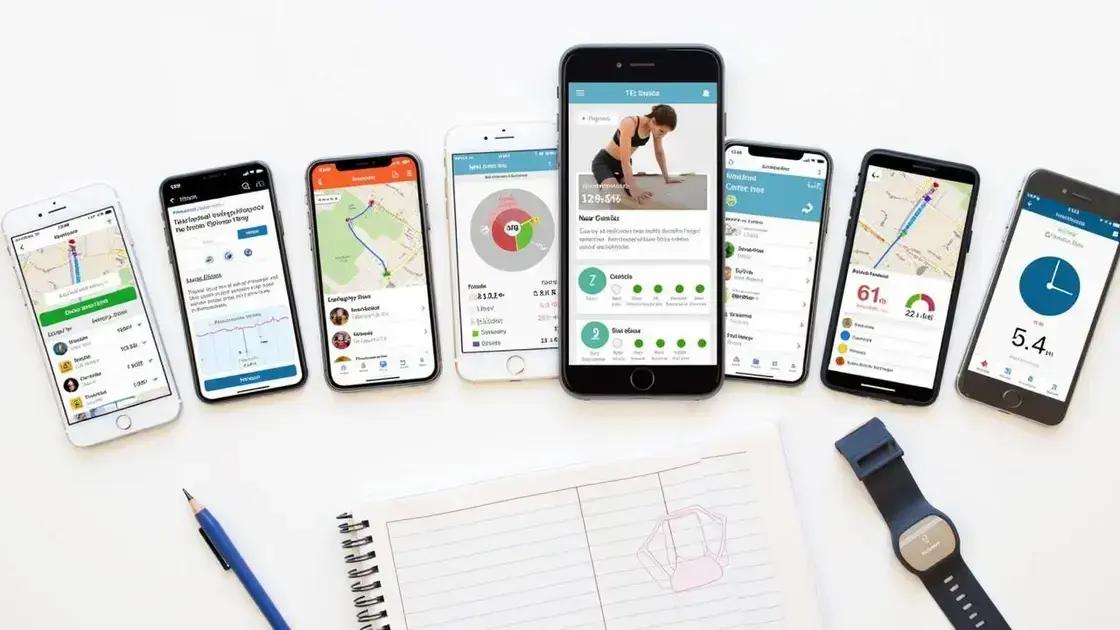To effectively track progress in your workouts, utilize tools like fitness apps and log your performance regularly. Set realistic goals using the SMART criteria, listen to your body, and adjust your routine based on your progress to stay motivated and achieve better results.
Tracking progress in your workouts is essential for achieving fitness goals and staying motivated. By accurately measuring your efforts, you can identify what works best for you and make necessary adjustments. This article will delve into various methods and tools for effectively tracking your workout progress, ensuring that you stay on course and achieve desired results.
Understanding the Importance of Tracking Workouts
![]()
Understanding the importance of tracking workouts is vital for anyone serious about fitness. When you track your workouts, you are taking an active role in your fitness journey. By keeping a record, you can clearly see your progress over time, which helps you stay motivated.
One major benefit of tracking your workouts is accountability. When you know you are monitoring your performance, you are more likely to push yourself harder and achieve better results. This can lead to improved strength, endurance, and overall fitness.
Additionally, tracking helps you identify patterns in your performance. Are you consistently lifting heavier weights? Are your cardio sessions getting longer? Recognizing these trends allows you to build on your successes and set new, achievable goals.
Another reason to track your workouts is to spot areas for improvement. If you notice that you are not progressing in certain exercises, it may be time to change your routine or seek advice on form and technique. This can prevent injury and help maximize your gains.
Moreover, documenting your workouts can help legitimize your fitness achievements. When you can look back and see how far you’ve come, it builds confidence. It also gives you a visual representation of your hard work, which can be inspiring.
In summary, tracking workouts is not just a chore; it is an essential tool that can enhance your fitness experience and results. Whether you keep a detailed log or use an app, find a tracking method that works for you and incorporate it into your fitness routine.
Tools and Apps for Monitoring Progress

There are many tools and apps available to help you monitor your progress effectively. These applications can be very beneficial in tailoring your fitness journey. Here are some popular options:
1. MyFitnessPal: This user-friendly app allows you to log your workouts and track your nutrition. You can set fitness goals, and it helps you keep an eye on your caloric intake as well as your exercise regimen.
2. Fitbit: If you own a Fitbit device, the accompanying app syncs your data to track steps, heart rate, and workout sessions. It provides insights and trends that help you increase your activity levels over time.
3. Strava: This app is perfect for runners and cyclists. You can track your routes, speeds, and distances, making it great for those who love outdoor activities. Strava also includes social features to connect with friends.
4. Jefit: Jefit is fantastic for weight training. This app offers a variety of workout plans and allows you to log your lifts and repetitions. It helps you plan routines and measure your progress effectively.
5. Google Sheets or Excel: Sometimes, the old-fashioned way can be great too. Using spreadsheets can help you customize your tracking methods. You can create charts, graphs, and other visual aids to keep you on track.
Each of these tools can help monitor different aspects of your workouts and overall health. Choosing the right tool depends on your fitness goals and preferences, but they all offer valuable ways to track your progress.
Setting Realistic Fitness Goals

Setting realistic fitness goals is crucial for success in your workout journey. When your goals are achievable, you are more likely to stay motivated and committed. Here are some key points to consider:
1. Start with the SMART criteria: SMART stands for Specific, Measurable, Achievable, Relevant, and Time-bound. For instance, instead of saying “I want to get fit,” you might say, “I will run 3 miles in under 30 minutes within 8 weeks.” This way, you have a clear target.
2. Break it down: Large goals can be overwhelming. Break your main goal into smaller, manageable steps. For example, if you want to lose 20 pounds, aim to lose 1-2 pounds per week. This makes your goal feel more reachable.
3. Consider your current fitness level: Setting goals should reflect where you are in your fitness journey. If you’re a beginner, starting with lower weights or shorter distances is wise. Progress will happen over time.
4. Set both short-term and long-term goals: Short-term goals keep you motivated regularly, while long-term goals provide the bigger picture. Celebrate small achievements along the way to keep your spirits high.
5. Be flexible: Life can throw challenges your way. If you find your goals are not realistic due to work or personal reasons, adjust them as needed. It’s better to modify your goals than to give up altogether.
In essence, remember that setting realistic fitness goals is about creating a path that works for you. By following these tips, you can set yourself up for success in your workout routine.
How to Adjust Your Routine Based on Progress

Adjusting your routine based on progress is essential for continued growth and improvement in your workouts. Here are key strategies to help you make effective adjustments:
1. Evaluate your progress regularly: Set aside time each week or month to review your workout logs. Look for trends in your performance, such as increased strength or endurance. This will help you identify what’s working and what needs change.
2. Listen to your body: Pay close attention to how you feel during and after workouts. If you’re constantly fatigued or in pain, it may be time to reduce intensity or take extra rest days. Adjusting your routine to prioritize recovery can prevent burnout.
3. Change up your exercises: If you notice that your progress has stalled, try varying your routine. This could include changing the types of exercises you do, the order of your workouts, or even the weights you use. New challenges can stimulate growth.
4. Increase intensity gradually: To continue making gains, gradually increase the challenge of your workouts. This can be done by adding more weight, increasing the duration, or shortening rest times. Small changes can lead to significant improvements over time.
5. Set new goals: As you achieve the goals you initially set, it’s time to establish new ones. Challenge yourself with more ambitious targets to keep your motivation high. Ensure these new goals are still realistic and align with your current fitness level.
By consistently evaluating and adjusting your routine based on your progress, you can stay on track and continue to make strides in your fitness journey.
In summary, tracking progress in your workouts is essential for achieving your fitness goals
By regularly evaluating your progress, utilizing the right tools and apps, setting realistic goals, and adjusting your routine based on your results, you can create a roadmap to success.
Understanding the importance of monitoring your workouts will keep you motivated and focused. With a clear strategy and commitment, you can overcome challenges and celebrate your achievements along the way.
Embrace the journey and remember that every step, no matter how small, brings you closer to your fitness aspirations.
FAQ – Frequently Asked Questions about Tracking Progress in Your Workouts
Why is tracking progress in workouts important?
Tracking progress helps you stay accountable, identify patterns in your performance, and set realistic goals for continuous improvement.
What tools can I use to monitor my workout progress?
You can use apps like MyFitnessPal, Fitbit, Strava, and Jefit, or even simple spreadsheet tools like Google Sheets and Excel.
How can I set realistic fitness goals?
Utilize the SMART criteria—Specific, Measurable, Achievable, Relevant, and Time-bound—to set clear and attainable fitness goals.
How often should I adjust my workout routine?
Regularly evaluate your performance, ideally every week or month, and adjust your routine based on your progress and how you feel.
What should I do if I’m not seeing progress?
Consider changing your exercises, increasing intensity, or listening to your body for potential adjustments in your routine.
Is it necessary to track nutrition as well?
Yes, tracking nutrition alongside workouts provides a comprehensive view of your fitness journey and helps optimize your results.












